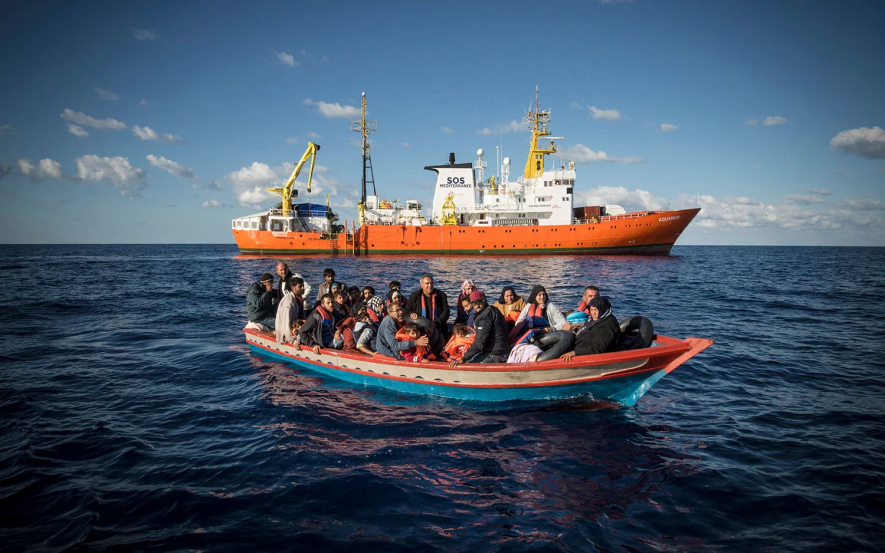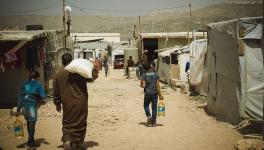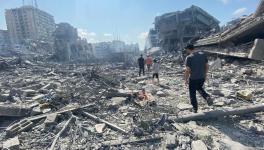The Real Effects of Fake Propaganda on Migrants

Aquarius migrant rescue ship. (Photo: Anthony Jean / SOS MEDITERRANEE)
Throughout the world, 2018 saw narratives of migration dominating politics, and being used to polarize and divide people. This was especially prevalent in the countries of the Global North, where right-wing forces continued to raise the specter of ‘invasions by foreigners’ to explain the economic crises caused by neoliberalism. The tactic even won some electoral dividends even as distress migration to Europe registered a 95% decline from its peak in 2015.
The trend of scaremongering and polarization was perhaps deployed most crudely by US president Donald Trump, who has shut down the country’s government as Congress refused to sanction $5 billion for construction of a wall on the southern border. Trump also kept abusing and threatening to use force against members of successive migrant caravans comprising thousands of poor people who left their homelands due to the policies of governments supported by the US. The death of two Guatemalan children in December this year yet again revealed the insensitivity of US authorities in dealing with the issue. The migrants continued to walk through, defiant and refusing to relent before ill-treatment by both Mexican and US authorities, including the tear-gassing of women and children. On the other hand, mass mobilizations by the people were a sign of hope that the people would not stand for such blatant polarization.
In Myanmar, the Rohingyas, the largest stateless population on the planet, continued to stare at an uncertain future. Despite the looming threat to their lives, Rohingya refugees in Bangladesh face the imminent threat of being transferred to Myanmar after the two countries signed a reparation treaty. Report after report has exposed the scale of crimes against humanity committed by Myanmarese military and Buddhist militias, ranging from mass executions to mass rape against the Rohingya population. The series of massacres in 2017 led to a mass exodus of three-quarters of a million Rohingyas to neighboring Bangladesh, the deaths of at least 10,000 people, and the destruction of over 37,000 Rohingya homes and structures.
Meanwhile, in Europe, fearful of losing ground to far-right parties, the EU and governments of various member states undertook a rightward shift themselves. This shift manifested in the form of policies which contravene the minimum protection offered to the migrants by recognizing certain rights of asylum seekers and certain human rights as a fundamental part of the EU laws.
This contravention of EU laws is executed by paying countries outside Europe, such as Turkey and Libya to use forceful and violent methods to stop the migrants before they reach the European border, from where the EU laws become applicable. It is this ‘outsourcing’ that has been largely responsible for the decrease in migration to the EU.
“[T]hings are moving in the right direction, mostly because we have been focused on external border control and cooperation with third countries, which have brought down the number of irregular migrants from almost 2 million in 2015 to fewer than 100,000 this year,” acknowledged. European Council president Donald Tusk at the EU summit in Salzburg, Austria, in September this year.

By last year, when a total of 68.5 million people were displaced due to armed conflict and violence across the world â about 25.4 million of whom were forced to flee from their countries â about 15 walls stood tall in their way to âsafetyâ on European soil.
The long crackdown
In exchange for 3 billion euros from the EU in 2015, “Syrian refugees attempting to cross into Turkey at unofficial crossing points are summarily pushed back into Syria and some asylum seekers and smugglers attempting the crossing have been shot dead or beaten by Turkish border guards,” stated a Human Rights Watch (HRW) report on Turkey last year. Only the year before, Turkey had actually instituted laws to protect migrants. However, in the year that Turkey provided these protections, the EU raised “serious concerns” about the state’s interference with the independence of the judiciary and crackdown on freedom of speech. No progress was seen in Turkey’s attempts to accede to the EU.
The next year, after the EU agreed to speed up talks on Turkey’s EU membership and dangled the prospect of visa-free travel for the Turkish citizens in most of the EU countries, apart from an offer of 3 billion euros, Turkey accepted the mission from the EU to choke the eastern Mediterranean route. Months later, the EU turned off the heat on Turkey for violations of various human and civil rights.
At the EU summit in July this year, German Chancellor Angela Merkel, who has been deemed the “de facto leader of the European Union”, commended Turkey for “doing a tremendous job” in choking the eastern Mediterranean route. The European Commission promised an additional 3 billion euros to help Turkey build a “Facility for Refugees”.
The central Mediterranean route has also been successfully choked with the help of Libya, which was roped in last year with an assurance of 237 million euros.
According to a 2017 report by HRW, trained and equipped by EU, the “Libyan Coast Guards or Navy intercepted boats and returned the migrants and refugees back to land and into detention centers, often subjecting the migrants they intercepted to physical and verbal abuse. Officials and militias held migrants and refugees in prolonged detention without judicial review and subjected them to poor conditions, including overcrowding and insufficient food. Guards and militia members subjected migrants and refugees to beatings, forced labor, and sexual violence.”
Furthermore, the waters around Libya where its coastguards operate have been declared off-limits to the rescue ships operated by NGOs.This has increased the rate of death among the people attempting the crossing, even though the total number of crossings have seen a sharp decline.
“Support for the Libyan Coast Guard.. including the establishment of a Libyan search and rescue region, has also resulted in increased numbers of people… returned to Libya. Once in Libya, they are detained with no possibility of release by UNHCR except for the purpose of evacuation to a third country,” stated a UNHCR report released in September this year. As a result of these harsh measures taken by the EU, the number of migrants arriving from Libya declined by 82% in less than a year, from 172,000 in August 2017 to 30,800 in July 2018.
Congratulating itself for these achievements, the EU, in 2018, decided not only to continue these policies but also to rope in other countries in the Sahel region of Africa to serve the Union.
Xenophobic paranoia
The cost of these ‘successful’ policies of the EU has been paid by a large number of migrants who have died in the seas due to the restrictions imposed on rescue vessels, by a larger number who have been detained, tortured and harassed by security agencies in numerous African and West Asian countries in the periphery of Europe, and by those who have been intercepted by the the European Border and Coast Guard Agency called the ‘Frontex’, whose budget has been further expanded by this year’s proposal to 11 billion euros for the period of 2021 to 2027.
But the migrants have not been the only ones paying a price for this paranoia. The concept of a united EU, within which the Europeans could travel freely, has itself come under threat. Initially, it was the countries in the periphery of Europe – such as Greece, Spain and Bulgaria – that were building walls along its borders. However, this trend has now become far more common.
A 329-km long wall stands on Hungary’s border with Croatia, and another 151-km long wall along its border with Serbia. Fearful of the migrants who had reached Greece, Macedonia built a wall on its Greek border. Austria, where the previous EU summit was organized, raised a wall along its border with Slovenia, which in turn erected a wall on its Croatian border.
In November this year, when Europe was celebrating the 29th anniversary of the fall of the 155-kilometre-long Berlin wall, there stood a total of about a 1,000 km of walls inside and around Europe, a recent report noted.
Get the latest reports & analysis with people's perspective on Protests, movements & deep analytical videos, discussions of the current affairs in your Telegram app. Subscribe to NewsClick's Telegram channel & get Real-Time updates on stories, as they get published on our website.
























